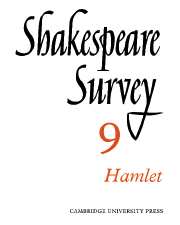Book contents
- Frontmatter
- Studies in Hamlet, 1901–1955
- English Hamlets of the Twentieth Century
- The Date of Hamlet
- Hamlet and the Court of Elsinore
- Hamlet’s ‘Sullied’ or ‘Solid’ Flesh: A Bibliographical Case–History
- Hamlet at the Globe
- Hamlet Costumes from Garrick to Gielgud
- Hamlet at the Comédie Française: 1769–1896
- The New Way with Shakespeare’s Texts: An Introduction for Lay Readers. III. In Sight of Shakespeare’s Manuscripts
- Shakespeare in the Bibliotheca Bodmeriana
- An Unpublished Contemporary Setting of a Shakespeare Song
- Garrick’s Stratford Jubilee: Reactions in France and Germany
- Shakespeare and Bohemia
- International Notes
- Shakespeare Productions in the United Kingdom: 1954
- The Tragic Curve: A Review of two Productions of Macbeth
- The Year's Contributions to Shakespearian Study 1 Critical Studies
- 2 Shakespeare’s Life, Times and Stage
- 3 Textual Studies
- Book Received
- Index
- Plate Section
The New Way with Shakespeare’s Texts: An Introduction for Lay Readers. III. In Sight of Shakespeare’s Manuscripts
Published online by Cambridge University Press: 28 March 2007
- Frontmatter
- Studies in Hamlet, 1901–1955
- English Hamlets of the Twentieth Century
- The Date of Hamlet
- Hamlet and the Court of Elsinore
- Hamlet’s ‘Sullied’ or ‘Solid’ Flesh: A Bibliographical Case–History
- Hamlet at the Globe
- Hamlet Costumes from Garrick to Gielgud
- Hamlet at the Comédie Française: 1769–1896
- The New Way with Shakespeare’s Texts: An Introduction for Lay Readers. III. In Sight of Shakespeare’s Manuscripts
- Shakespeare in the Bibliotheca Bodmeriana
- An Unpublished Contemporary Setting of a Shakespeare Song
- Garrick’s Stratford Jubilee: Reactions in France and Germany
- Shakespeare and Bohemia
- International Notes
- Shakespeare Productions in the United Kingdom: 1954
- The Tragic Curve: A Review of two Productions of Macbeth
- The Year's Contributions to Shakespearian Study 1 Critical Studies
- 2 Shakespeare’s Life, Times and Stage
- 3 Textual Studies
- Book Received
- Index
- Plate Section
Summary
If these articles retain the interest of any reader, lay or learned, actor or ‘customer’, let him picture the writer wrapped in a white sheet and surrounded by the tapers of penitence as he sits at his desk to pick up the thread of his discourse after a break of two years. For a serial in an annual review is in any case absurd, and one that began in 1953 with a brief introduction and continued in 1954 with a lengthy digression has become an inexcusable contradiction in terms. The sinner can only plead that last year’s article on Romeo and Juliet will at least have shown that the “new way” involves issues of real importance to actors and general readers.
The old way with Shakespeare's texts, as I pointed out in my introduction, was a purely eclectic one since editors knew little more than the editors of the ancient classics about the character of their authors' original manuscripts or about the intermediary links between those manuscripts and the earliest printed texts; and what they did know only weakened any confidence they might have had in the integrity of the latter. All this, I also pointed out, is now changed. Thanks to the rise of modern bibliography, together with an increase in our knowledge of the Elizabethan and Jacobean theatre and of the dramatic documents that have come down from that period, confidence has largely replaced perplexity or despair in regard to the quartos and First Folio; and editors today feel tolerably sure that a Shakespearian manuscript or at worst a theatrical prompt-book lies either immediately, or at only one or two removes, behind most of them. The change was revolutionary and, as I noted finally, it came suddenly. There was little opposition and within a decade most scholars had been converted. "The door of Shakespeare's workshop stands ajar"1 I was emboldened to write in 1921.
- Type
- Chapter
- Information
- Shakespeare Survey , pp. 69 - 80Publisher: Cambridge University PressPrint publication year: 1956



